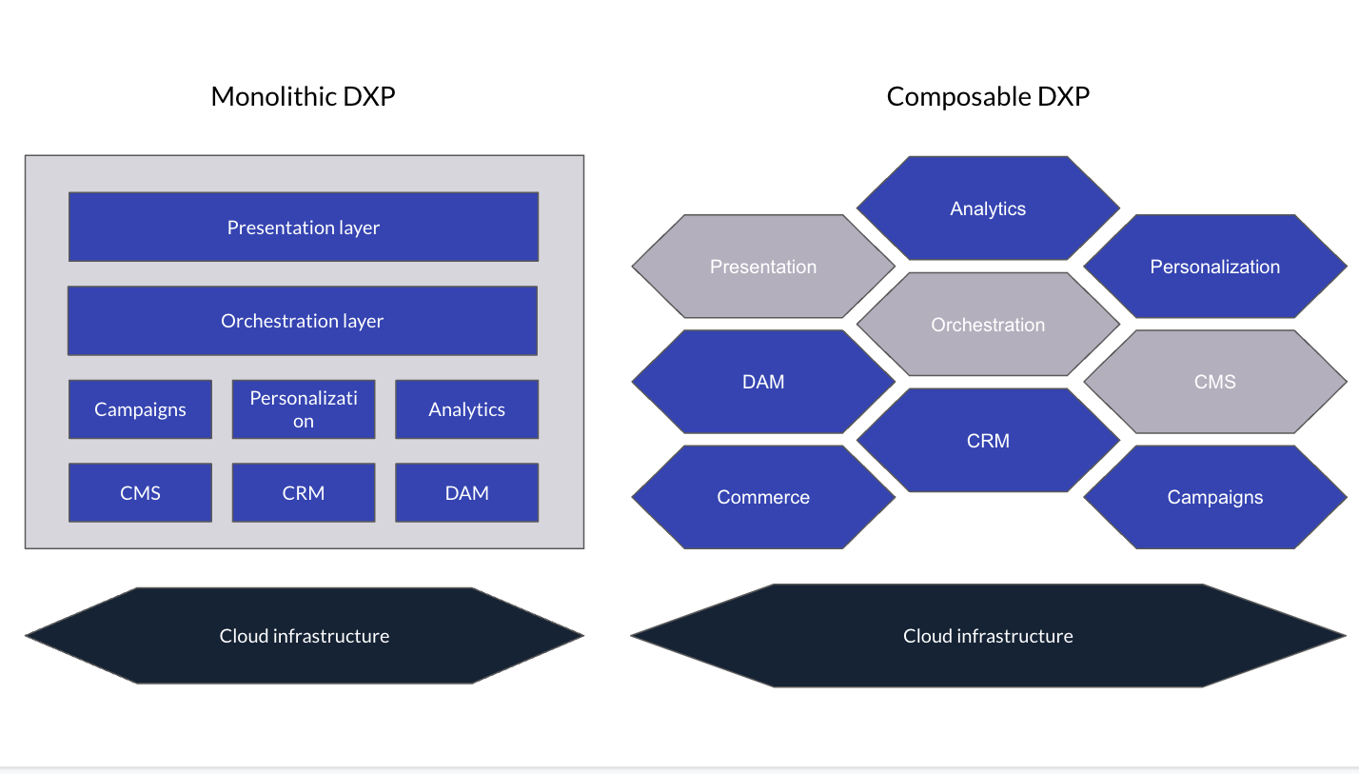
Composable DXP for Umbraco
Simplifying integrations

Umbraco’s focus has always been on making things simpler.
And simplifying integrations to other software is a big part of that. Therefore, one of the visions we have is:
''That we enable customers and partners to compose their preferred tech stack by simplifying integrations - Composable DXP''
But what does that mean? How does it work in practice and how will our stakeholders feel the benefits of this new effort?
Let me set some words and details on the work we do in the domain we call ''Composable DXP''. This work is based and prioritized in close collaboration with Umbraco’s Solution Partners, who also pointed us in this direction.
What is a DXP?
A digital experience platform (DXP) is a platform that allows digital experiences to seamlessly connect across websites, apps, and other digital touchpoints that go beyond managing content (in a CMS, for example). This involves integrating functionality together into a unified platform to extend functionality.

DXPs are a particularly useful setup for MarTech (marketing technology), where teams can integrate CRM (Customer Resource Management), DAM (Digital Assets Management) analytics, and essentially any tools and technology that a team wants to work with!
DXPs can be built and created mainly on two different architectures - monolithic (like a legacy or suite CMS), or composable.
Learn more in our article "What is Composable DXP?"
Why does Umbraco focus on Composable DXP?
Content is not enough anymore. As a CMS, Umbraco has been the main component when building a digital experience. For many years, the website was either the major software, or other functions or applications were built within as customized expansions.
The digital landscape as we know it is changing. When building a composable DXP, with different components such as commerce, recommendation, or PIM, we need to make sure that everything is tied together. That’s how we can share content, products, user data, and insights across the components through a user-friendly, customized solution. Essentially, a composable DXP creates the foundation to manage all content and campaigns in a central hub, with the flexibility and ability to shift and replace the software within whenever you need it.
Now, you might be wondering ''aren’t monolithic solutions also a central hub''?
Well, yes - but there’s more to it than that.
Composable DXP applications should be built out of smaller units, so-called packaged business capabilities (PBCs) that are task-oriented and independently deployable. This means that you have the freedom to compose your own DXP and use the tools of your choice, instead of relying on a single product.
As Gartner explains, ''to achieve agility and flexibility in delivering experiences, modular packaged business capabilities (PBCs) are brought together to form composable digital commerce platforms that align to the future of applications.''

It can be complex - but we’re here to make it simpler
The desired agility and flexibility in a composable DXP comes with a price; complexity.
Complexity usually comes to the surface when integrating different software to each other through APIs or others.
This is where Umbraco will help. We’re taking the responsibility for having integrations ready to save development and time to market. We’ll offer uncomplicated integrations - ones that are simple and straightforward to build on top of.

At Umbraco, we aim to do our utmost and assure that an Umbraco user will have the easiest access to integrations within a composable DXP. That means developing beneficial integrations, partnering with other vendors with an upgraded program, and facilitating the continuous conversation on our tech stack with stakeholders.
This is our value proposition to end customers and stakeholders:
''Freedom to design the digital experience platform that fit your business needs''
We:
- help you create a personalized digital experience platform through easy integration to all your preferred technology solutions
- enable a low friction connection to all your selected digital experience tools securing faster time-to-market
- empower you to take control and create a customized digital experience platform through seamless integration with the tech provider of your choice
- give you the opportunity to build a composable infrastructure that keeps your business strategy and IT priorities aligned as every organization is unique
Here’s how we’re going to do it
In 2022, we will:
👉 upgrade the Marketplace on umbraco.com, to give more visibility to integrations from Technology Partners, Community, and HQ. The same integrations will get more promotion in the backoffice from Umbraco 9 and onwards. We also plan to build a new software design for integrations to have a shared library and smoother handling across our.umbraco.com, Marketplace at umbraco.com, and the backoffice.
👉 spearhead the development of obvious integrations to software we know our solution partners use the most when building DXPs. The integrations that we’re planning to develop on in 2022 so far are Shopiify+, Zapier, SalesForce, Microsoft Dynamics, and many more. We’re already working on these projects together with our Solution Partners and we’ll encourage agencies to take part in the development.
👉 be talking to several Gold Partners monthly, in order to understand their preferred tech stack and prioritize our efforts accordingly.
👉 continue to air the popular Tech Webinars once a month. We have a lot of interesting webinars lined up for the spring with guests as Uniform, Enterspeed, and others.
👉 spend more time in the marketing of composable DXP, making sure that the end customers, existing and potential, understand that Umbraco will be easier to use, and that there’s no reason to choose a monolith solution to get several applications to work together.
We can't wait to talk more about Composable DXP and Umbraco at Codegarden 2022 🙌
Any recommendations, ideas, or comments are more than welcome. We aim to include our stakeholders as much as possible in this undertaking, so we’d love to hear from you!